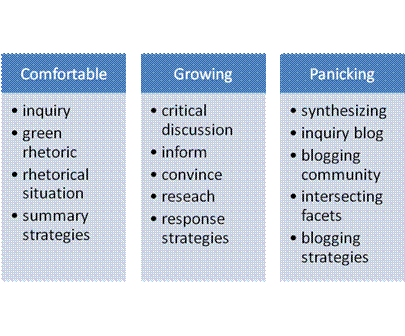Day 10 (Wednesday, September 16th)
Day 10 (Wednesday, September 16)
Lesson Objectives
Students will
Prep
Because today’s class will focus on a rhetorical viewing of Leonard’s film, your preparation should include re-viewing and annotating the film. Read “A Cautionary Video of America’s Stuff,” and otherwise learn as much as you can about the context of the film.
Materials
Your annotated copy of “A Cautionary Video of America’s Stuff,”
Notes from the movie, talking points and discussion questions
Copies of Assignment 2 (unless you had students print this out for homework)
Activities
Attendance and Lead-in (3-5 minutes)
Take attendance your usual way and introduce class, focusing on how today’s activities will help students understand the rhetorical situation of their upcoming assignment.
WTL Movie Review (5-10 Minutes)
With blogging growing in popularity, these days anyone can go out to the movies, come home, and become and “influential” critic on Twitter, Facebook, etc. Let’s write a movie review keeping in mind a specific rhetorical situation. In this case, you are the reviewer and you are writing to an audience of educators who are thinking of using the movie in their lesson plans.
Prompt: Educators should/shouldn’t use Annie Leonard’s movie, “The Story of Stuff,” because…
Ask students to provide specific reasons and details from the movie so you can collect the WTL and hold them accountable for the homework.
Introduce Assignment 2 (10-15 minutes)
As you introduce Assignment Two, consider what worked and didn’t work when you introduced the first assignment. You might revisit the comfort circle metaphor to generate new terms and assess terms they should be more comfortable with at this point.
An example of a potential three-columned list that your class might generate for Assignment 2:

Small group discussions (15-18 minutes)
In five or six small groups, ask students to consider “The Story of Stuff,” and the New York Times article, “A Cautionary Video…” Ask them to finish their discussion by finding aspects of these texts that connect in some way to earlier readings from the semester (Quinn, Hawken, the Seed Panel, etc.) For example, is a rhetoric of doom emerging within the rhetoric of green? How about a rhetoric of hope? Which is louder?
The Rhetoric of Green…for children?
Frame of Reference
Continuing the Conversation
Synthesizing Rhetoric
At this point we’ve read enough texts to begin identifying certain common themes within the rhetoric of green. Consider all of the reading we’ve done so far. Can you begin making concrete connections between ideas in the different texts?
Give students about 10 minutes to discuss and jot down answers to the questions, and then ask each group to present their findings, or have a whole class discussion to which each group contributes
Assign homework for Friday (2-3 minutes)
Homework for Friday